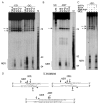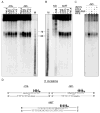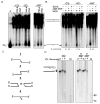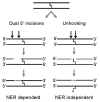Distortion-dependent unhooking of interstrand cross-links in mammalian cell extracts
- PMID: 18702509
- PMCID: PMC2629582
- DOI: 10.1021/bi800925e
Distortion-dependent unhooking of interstrand cross-links in mammalian cell extracts
Abstract
Interstrand cross-links (ICLs) are formed by many chemotherapeutic agents and may also arise endogenously. The mechanisms used to repair these lesions remain unclear in mammalian cells. Repair in Escherichia coli and Saccharomyces cerevisiae requires an initial unhooking step to release the tethered DNA strands. We used a panel of linear substrates containing different site-specific ICLs to characterize how structure affects ICL processing in mammalian cell extracts. We demonstrate that ICL-induced distortions affect NER-dependent and -independent processing events. The NER-dependent pathway produces dual incisions 5' to the site of the ICL as described previously [Bessho, T., et al. (1997) Mol. Cell. Biol. 17 (12), 6822-6830] but does not release the cross-link. Surprisingly, we also found that the interstrand cross-linked duplexes were unhooked in mammalian cell extracts in a manner independent of the NER pathway. Unhooking occurred identically in extracts prepared from human and rodent cells and is dependent on ATP hydrolysis and metal ions. The structure of the unhooked product was characterized and was found to contain the remnant of the cross-link. Both the NER-mediated dual 5' incisions and unhooking reactions were greatly stimulated by ICL-induced distortions, including increased local flexibility and disruption of base pairs surrounding the site of the ICL. These results suggest that in DNA not undergoing transcription or replication, distortions induced by the presence of an ICL could contribute significantly to initial cross-link recognition and processing.
Figures

 = 32P label positions 1-5; ■ denotes every 10th base from the 5’ end; ▼ denotes every 10th base from the 3’ side;
= 32P label positions 1-5; ■ denotes every 10th base from the 5’ end; ▼ denotes every 10th base from the 3’ side;

 = 32P label; arrows indicate location of incisions.
= 32P label; arrows indicate location of incisions.
 = 32P label; arrows indicate location of incisions.
= 32P label; arrows indicate location of incisions.



Similar articles
-
Cross-link structure affects replication-independent DNA interstrand cross-link repair in mammalian cells.Biochemistry. 2010 May 11;49(18):3977-88. doi: 10.1021/bi902169q. Biochemistry. 2010. PMID: 20373772 Free PMC article.
-
DNA interstrand crosslink repair in mammalian cells: step by step.Crit Rev Biochem Mol Biol. 2010 Feb;45(1):23-49. doi: 10.3109/10409230903501819. Crit Rev Biochem Mol Biol. 2010. PMID: 20039786 Free PMC article. Review.
-
Effect of cross-link structure on DNA interstrand cross-link repair synthesis.Chem Res Toxicol. 2009 Jul;22(7):1285-97. doi: 10.1021/tx9000896. Chem Res Toxicol. 2009. PMID: 19580249 Free PMC article.
-
Replication-Dependent Unhooking of DNA Interstrand Cross-Links by the NEIL3 Glycosylase.Cell. 2016 Oct 6;167(2):498-511.e14. doi: 10.1016/j.cell.2016.09.008. Epub 2016 Sep 29. Cell. 2016. PMID: 27693351 Free PMC article.
-
Repair of genomic interstrand crosslinks.DNA Repair (Amst). 2024 Sep;141:103739. doi: 10.1016/j.dnarep.2024.103739. Epub 2024 Jul 30. DNA Repair (Amst). 2024. PMID: 39106540 Review.
Cited by
-
Cross-link structure affects replication-independent DNA interstrand cross-link repair in mammalian cells.Biochemistry. 2010 May 11;49(18):3977-88. doi: 10.1021/bi902169q. Biochemistry. 2010. PMID: 20373772 Free PMC article.
-
DNA interstrand crosslink repair in mammalian cells: step by step.Crit Rev Biochem Mol Biol. 2010 Feb;45(1):23-49. doi: 10.3109/10409230903501819. Crit Rev Biochem Mol Biol. 2010. PMID: 20039786 Free PMC article. Review.
-
Probing DNA interstrand cross-link formation by an oxidized abasic site using nonnative nucleotides.Bioorg Med Chem. 2011 Oct 1;19(19):5788-93. doi: 10.1016/j.bmc.2011.08.024. Epub 2011 Aug 18. Bioorg Med Chem. 2011. PMID: 21903404 Free PMC article.
-
The role of ADP-ribosylation in regulating DNA interstrand crosslink repair.J Cell Sci. 2016 Oct 15;129(20):3845-3858. doi: 10.1242/jcs.193375. Epub 2016 Sep 1. J Cell Sci. 2016. PMID: 27587838 Free PMC article.
-
The differences between ICL repair during and outside of S phase.Trends Biochem Sci. 2013 Aug;38(8):386-93. doi: 10.1016/j.tibs.2013.05.004. Epub 2013 Jul 3. Trends Biochem Sci. 2013. PMID: 23830640 Free PMC article. Review.
References
-
- McHugh PJ, Spanswick VJ, Hartley JA. Repair of DNA interstrand crosslinks: molecular mechanisms and clinical relevance. Lancet Oncol. 2001;2:483–490. - PubMed
-
- Lehoczky P, McHugh PJ, Chovanec M. DNA interstrand cross-link repair in Saccharomyces cerevisiae. FEMS Microbiol Rev. 2007;31:109–133. - PubMed
-
- Cole RS, Sinden RR. Repair of cross-linked DNA in Escherichia coli. Basic Life Sci. 1975;5B:487–495. - PubMed
Publication types
MeSH terms
Substances
Grants and funding
LinkOut - more resources
Full Text Sources

